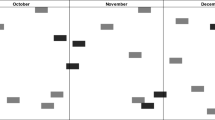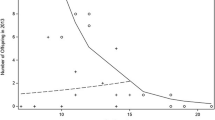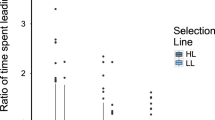Abstract
COMPETITIVE interaction between females of the same social group is characteristic of most primate species1–3. In Old World monkeys, females of high social rank maintain priority of access to scarce resources and harass low-ranking companions1–6. But different field studies have found differing correlations between female dominance and reproductive success: several populations show an advantage of rank whereas others do not1,3,5,7. Although such variation may reflect divergent levels of predation, food availability or social stress in different environments, female competitive ability may also be balanced by significant reproductive costs and thus be subject to strong stabilizing selection. We report here that high-ranking female baboons (Papio cynocephalm anubis) at Gombe National Park, Tanzania, enjoy shorter interbirth intervals, improved infant survival, and accelerated maturation of their daughters. These advantages, however, are countered by a significantly higher probability of miscarriage, and a proportion of high-ranking females suffer from reduced fertility.
This is a preview of subscription content, access via your institution
Access options
Subscribe to this journal
Receive 51 print issues and online access
$199.00 per year
only $3.90 per issue
Buy this article
- Purchase on Springer Link
- Instant access to full article PDF
Prices may be subject to local taxes which are calculated during checkout
Similar content being viewed by others
References
Silk, J. in Primate Societies (eds Smuts, B. B., Cheney, D. L., Seyfarth, R. M., Wrangham, R. W. & Struhsaker, T. T.) 318–329 (Univ. Chicago Press, Chicago, 1987).
Walters, J. R. & Seyfarth, R. M. in Primate Societies (eds Smuts, B. B., Cheney, D. L., Seyfarth, R. M., Wrangham, R. W. & Struhsaker, T. T.) 306–317 (Univ. Chicago Press, Chicago, 1987).
Chapais, B. in Coalitions and Alliances in Humans and Other Animals (eds Harcourt, A. H. & deWaal, F. B. M.) 29–60 (Oxford Univ. Press, Oxford, 1992).
Wasser, S. K. in Social Behavior of Female Vertebrates (ed. Wasser, S. K.) 349–390 (Academic, New York, 1983).
Lee, P. C. J. Zool. 213, 409–422 (1987).
Abbott, D. H. J. Zool. 213, 455–470 (1987).
Altmann, J., Hausfater, G. & Altmann, S. A. in Reproductive Success (ed. Clutton-Brock, T. H.) 403–418 (Univ. Chicago Press, Chicago, 1988).
Packer, C. Nature 255, 219–220 (1975).
Nash, L. T. Am. J. phys. Anthrop. 44, 63–77 (1976).
Owens, N. W. Behaviour 57, 241–259 (1976).
Packer, C. Anim. Behav. 27, 1–36 (1979).
Ransom, T. W. Beach Troop of the Gombe (Associated University Presses, New Brunswick, NJ, 1981).
Collins, D. A., Busse, C. D. & Goodall, J. in Infanticide (eds Hausfater, G. & Hardy, S. B.) 193–216 (Aldine, Hawthorne, NY, 1984).
Goodall, J. The Chimpanzees of Gombe (Harvard Univ. Press, Cambridge, MA, 1986).
Altmann, S. A. Lab. Anim. Digest 6, 7–10 (1970).
Smuts, B. B. & Nicolson, N. Am. J. Primatol. 19, 229–246 (1989).
Strum, S. C. & Western, J. D. Am. J. Primatol. 3, 61–76 (1982).
Bercovitch, F. B. & Strum, S. C. Behav. Ecol. Sociobiol. 33, 313–319 (1993).
Wasser, S. K. & Norton, G. Behav. Ecol. Sociobiol. 32, 273–281 (1993).
Hausfater, G., Altmann, J. & Altmann, S. A. Science 217, 752–755 (1982).
Sackett, G. P., Holm, R. A., Davis, A. E. & Fahrenbuck, E. E. in Proc. 5th Congr. Int. Primatological Society (eds Kondo, S., Kawai, M., Ehara, A. & Kawamura, S.) (Japan Science, Tokyo, 1975).
Fairbanks, L. A. & McGuire, M. T. Anim. Behav. 34, 1710–1721 (1986).
Hausfater, G. Dominance and Reproduction in Baboons (Karger, Basel, 1975).
Goy, R. W. & Resko, J. A. Recent Progr. Horm. Res. 28, 707 (1972).
vom Saal, F. J. Reprod. Fert. 86, 457–471 (1989).
Glickman, S. E., Frank, L. G., Holekamp, K. E., Smale, L. & Licht, P. Perspect. Ethol. 10, 87–117 (1993).
Yalcinkaya, T. M. et al. Science 260, 1929–1931 (1993).
Author information
Authors and Affiliations
Rights and permissions
About this article
Cite this article
Packer, C., Collins, D., Sindimwo, A. et al. Reproductive constraints on aggressive competition in female baboons. Nature 373, 60–63 (1995). https://doi.org/10.1038/373060a0
Received:
Accepted:
Issue Date:
DOI: https://doi.org/10.1038/373060a0
This article is cited by
-
Genetic correlations of direct and indirect genetic components of social dominance with fitness and morphology traits in cattle
Genetics Selection Evolution (2023)
-
Contrasting effects of male immigration and rainfall on rank-related patterns of miscarriage in female olive baboons
Scientific Reports (2021)
-
Infant Survival Among Free-Living Bonnet Macaques (Macaca radiata) in South India
International Journal of Primatology (2021)
-
Insights into the genetic foundation of aggression in Papio and the evolution of two length-polymorphisms in the promoter regions of serotonin-related genes (5-HTTLPR and MAOALPR) in Papionini
BMC Evolutionary Biology (2016)
-
Exceptional endocrine profiles characterise the meerkat: sex, status, and reproductive patterns
Scientific Reports (2016)
Comments
By submitting a comment you agree to abide by our Terms and Community Guidelines. If you find something abusive or that does not comply with our terms or guidelines please flag it as inappropriate.



